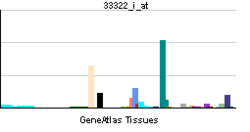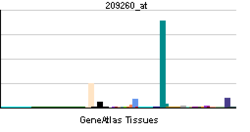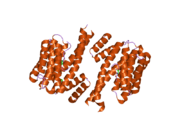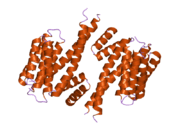Stratifin
14-3-3 protein sigma, or 14-3-3σ protein is a protein that is in humans and is encoded by the SFN gene.[1][2]
Interactions
Stratifin has been shown to interact with PLK4,[3] ERRFI1,[4] MARK3,[3][4] JUB[4] and YWHAG.[4]
References
- ↑ Leffers H, Madsen P, Rasmussen HH, Honore B, Andersen AH, Walbum E, Vandekerckhove J, Celis JE (Jul 1993). "Molecular cloning and expression of the transformation sensitive epithelial marker stratifin. A member of a protein family that has been involved in the protein kinase C signalling pathway". J Mol Biol 231 (4): 982–98. doi:10.1006/jmbi.1993.1346. PMID 8515476.
- ↑ "Entrez Gene: SFN stratifin".
- 1 2 Rual, Jean-François; Venkatesan Kavitha, Hao Tong, Hirozane-Kishikawa Tomoko, Dricot Amélie, Li Ning, Berriz Gabriel F, Gibbons Francis D, Dreze Matija, Ayivi-Guedehoussou Nono, Klitgord Niels, Simon Christophe, Boxem Mike, Milstein Stuart, Rosenberg Jennifer, Goldberg Debra S, Zhang Lan V, Wong Sharyl L, Franklin Giovanni, Li Siming, Albala Joanna S, Lim Janghoo, Fraughton Carlene, Llamosas Estelle, Cevik Sebiha, Bex Camille, Lamesch Philippe, Sikorski Robert S, Vandenhaute Jean, Zoghbi Huda Y, Smolyar Alex, Bosak Stephanie, Sequerra Reynaldo, Doucette-Stamm Lynn, Cusick Michael E, Hill David E, Roth Frederick P, Vidal Marc (Oct 2005). "Towards a proteome-scale map of the human protein-protein interaction network". Nature (England) 437 (7062): 1173–8. doi:10.1038/nature04209. PMID 16189514. Cite uses deprecated parameter
|coauthors=(help) - 1 2 3 4 Benzinger, Anne; Muster Nemone; Koch Heike B; Yates John R; Hermeking Heiko (Jun 2005). "Targeted proteomic analysis of 14-3-3 sigma, a p53 effector commonly silenced in cancer". Mol. Cell Proteomics (United States) 4 (6): 785–95. doi:10.1074/mcp.M500021-MCP200. ISSN 1535-9476. PMID 15778465.
Further reading
- Hermeking H (2005). "Extracellular 14-3-3sigma protein: a potential mediator of epithelial-mesenchymal interactions.". J. Invest. Dermatol. 124 (1): ix–x. doi:10.1111/j.0022-202X.2004.23534.x. PMID 15654940.
- Mhawech P (2005). "14-3-3 proteins--an update.". Cell Res. 15 (4): 228–36. doi:10.1038/sj.cr.7290291. PMID 15857577.
- Lodygin D, Hermeking H (2005). "The role of epigenetic inactivation of 14-3-3sigma in human cancer.". Cell Res. 15 (4): 237–46. doi:10.1038/sj.cr.7290292. PMID 15857578.
- Rasmussen HH, van Damme J, Puype M, et al. (1993). "Microsequences of 145 proteins recorded in the two-dimensional gel protein database of normal human epidermal keratinocytes.". Electrophoresis 13 (12): 960–9. doi:10.1002/elps.11501301199. PMID 1286667.
- Prasad GL, Valverius EM, McDuffie E, Cooper HL (1992). "Complementary DNA cloning of a novel epithelial cell marker protein, HME1, that may be down-regulated in neoplastic mammary cells.". Cell Growth Differ. 3 (8): 507–13. PMID 1390337.
- Hermeking H, Lengauer C, Polyak K, et al. (1998). "14-3-3 sigma is a p53-regulated inhibitor of G2/M progression.". Mol. Cell 1 (1): 3–11. doi:10.1016/S1097-2765(00)80002-7. PMID 9659898.
- Chan TA, Hermeking H, Lengauer C, et al. (1999). "14-3-3Sigma is required to prevent mitotic catastrophe after DNA damage.". Nature 401 (6753): 616–20. doi:10.1038/44188. PMID 10524633.
- Laronga C, Yang HY, Neal C, Lee MH (2000). "Association of the cyclin-dependent kinases and 14-3-3 sigma negatively regulates cell cycle progression.". J. Biol. Chem. 275 (30): 23106–12. doi:10.1074/jbc.M905616199. PMID 10767298.
- Samuel T, Weber HO, Rauch P, et al. (2002). "The G2/M regulator 14-3-3sigma prevents apoptosis through sequestration of Bax.". J. Biol. Chem. 276 (48): 45201–6. doi:10.1074/jbc.M106427200. PMID 11574543.
- Johnson BA, Stehn JR, Yaffe MB, Blackwell TK (2002). "Cytoplasmic localization of tristetraprolin involves 14-3-3-dependent and -independent mechanisms.". J. Biol. Chem. 277 (20): 18029–36. doi:10.1074/jbc.M110465200. PMID 11886850.
- Tian H, Faje AT, Lee SL, Jorgensen TJ (2002). "Radiation-induced phosphorylation of Chk1 at S345 is associated with p53-dependent cell cycle arrest pathways.". Neoplasia 4 (2): 171–80. doi:10.1038/sj/neo/7900219. PMC 1550321. PMID 11896572.
- Ku NO, Michie S, Resurreccion EZ, et al. (2002). "Keratin binding to 14-3-3 proteins modulates keratin filaments and hepatocyte mitotic progression.". Proc. Natl. Acad. Sci. U.S.A. 99 (7): 4373–8. doi:10.1073/pnas.072624299. PMC 123655. PMID 11917136.
- Urano T, Saito T, Tsukui T, et al. (2002). "Efp targets 14-3-3 sigma for proteolysis and promotes breast tumour growth.". Nature 417 (6891): 871–5. doi:10.1038/nature00826. PMID 12075357.
- Liu MY, Cai S, Espejo A, et al. (2002). "14-3-3 interacts with the tumor suppressor tuberin at Akt phosphorylation site(s).". Cancer Res. 62 (22): 6475–80. PMID 12438239.
- Strausberg RL, Feingold EA, Grouse LH, et al. (2003). "Generation and initial analysis of more than 15,000 full-length human and mouse cDNA sequences.". Proc. Natl. Acad. Sci. U.S.A. 99 (26): 16899–903. doi:10.1073/pnas.242603899. PMC 139241. PMID 12477932.
- Bhatia K, Siraj AK, Hussain A, et al. (2003). "The tumor suppressor gene 14-3-3 sigma is commonly methylated in normal and malignant lymphoid cells.". Cancer Epidemiol. Biomarkers Prev. 12 (2): 165–9. PMID 12582028.
- Kino T, Souvatzoglou E, De Martino MU, et al. (2003). "Protein 14-3-3sigma interacts with and favors cytoplasmic subcellular localization of the glucocorticoid receptor, acting as a negative regulator of the glucocorticoid signaling pathway.". J. Biol. Chem. 278 (28): 25651–6. doi:10.1074/jbc.M302818200. PMID 12730237.
- Nakajima T, Shimooka H, Weixa P, et al. (2004). "Immunohistochemical demonstration of 14-3-3 sigma protein in normal human tissues and lung cancers, and the preponderance of its strong expression in epithelial cells of squamous cell lineage.". Pathol. Int. 53 (6): 353–60. doi:10.1046/j.1440-1827.2003.01481.x. PMID 12787309.
- Rishi AK, Zhang L, Boyanapalli M, et al. (2003). "Identification and characterization of a cell cycle and apoptosis regulatory protein-1 as a novel mediator of apoptosis signaling by retinoid CD437.". J. Biol. Chem. 278 (35): 33422–35. doi:10.1074/jbc.M303173200. PMID 12816952.
| |||||||||||
This article is issued from Wikipedia - version of the Wednesday, September 02, 2015. The text is available under the Creative Commons Attribution/Share Alike but additional terms may apply for the media files.





